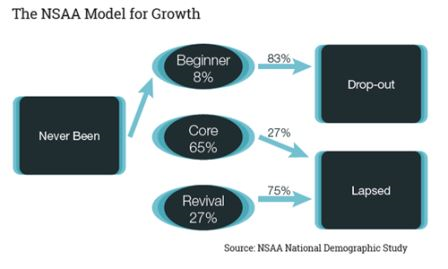
What are the demographic trends?
19% of skiers and snowboarders continue in the sport long-term. Millennial and Gen Z participants ski and ride less than prior generations.
What are ski areas doing to combat this?
Resorts have responded by developing a variety of "hardware" methods to combat these issues: state-of-the-art learning centers; ticket, lesson and equipment deals; increased attention to beginner equipment and employee incentives.
What are the challenges?
While these tangible efforts are encouraging, conversion has emerged as the predominant roadblock in the industry's ultimate goal of growing the sport. There are also issues of perception, inclusion, expense and time poverty.
What is being done?
Growing participation is a top priority for ski areas. Outlined below is a timeline of initiatives that have taken place in the last 20 years. That being said, there is still plenty of work to be done and there is no “silver bullet.” The solution requires consistent work by every segment of the ski industry, pulling together to reach a common goal. Each and every product, promotion and new skier that is converted is a step in the right direction. Simultaneously, NSAA continues to review the data and is working to develop new findings and tools to assist members with this challenge.
History of the Growth Model
2000: The Model for Growth was introduced as a method for critically analyzing the future of the ski/snowboard industry.
2002: A panel of key ski school managers and probe learning programs and experiences to understand specifically what techniques and procedures worked best from a teaching and conversion standpoint. A panel of recent consumers was separately convened. The ideas and recommendations generated by the professionals and consumer groups were synthesized into a detailed Conversion Cookbook.
2003: Beginner Research Findings
2004: Findings from the NSAA test sites
2006: The Way We Grow
2008: Future Demographics Series Supplement
2009: Learn to Ski and Snowboard Month introduced as the “trial component” of the Model’s Trial and Conversion formula.
2011: Conversion Cup Challenge introduced. The Challenge is a competition among member ski areas that awards the ski area with the best conversion program. Conversion being the process of turning beginner skiers and riders into repeat customers, and ultimately lifelong enthusiasts of the sport.
2013: NSAA endorses PHIT America. PHIT America is dedicated to increasing physical activity and fitness to improve the health of America.
2015: The Beginner Conversion Study is launched. It is a multi-year research project providing the industry with critical information about the behavior of first-time skiers and snowboarders. The research is based on surveys of new skiers and riders over a period of time. The study was paused in 2019.
2017: The Path to Growth was published. NSAA analyzed decades of research data and identified eight key challenges facing the future of the ski industry, including demographics and participation. The booklet provides ski area operators a tool to better understand the concerns and areas of opportunity for action.
2018: Conversion continues to be a challenge. Collectively we have inched forward and convert 19% of beginners compared to 15% in 2000. There are many resorts and ski areas who have done substantial work on this front. An updated Conversion Cookbook is now available to ski area members with discussion and strategies for areas to consider as they develop their conversion efforts. The Cookbook will be updated in 2020.
NSAA's Growth Committee convened in October 2018 to work on a long-term, sustainable model for growth. The ski area experts on this committee are tasked with helping the industry reach a goal of a three-year average of 60MM skier visits by 2025/26. Tactics include brainstorming new ways for inclusion, identifying ways to reach skier segments other than beginners, and how to change skier behavior to increase capacity and conversion.